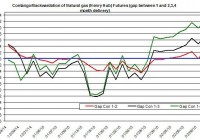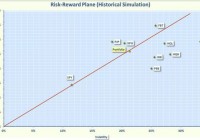A Peek Inside The Fidelity Contrafund
The Fidelity Contrafund has been an excellent performer, with 12.5% annual returns since inception. It has large positions in companies like Berkshire Hathaway, Google, and Apple, which have $200+ billion in cash between them. The one concern about this fund is the annual turnover rate of 45% which means the average stock is only held for a little over two years. The Fidelity Contrafund Fund (MUTF: FCNTX ) is one of the largest mutual funds in the world, with over $112 billion in assets. For a fund of that size, the stockpickers are unusually active – the Contrafund has an annual turnover rate of 45%, which means that each stock lasts in the portfolio for a little over two years on average. A turnover rate like this explains the difficulty in analyzing mutual funds – even if you like what you see inside the fund, there is no guarantee that those stocks will still be there a few years from now. That said, the Contrafund does deserve some benefit of the doubt due to its excellent performance over the course of its inception. It has given investors 12.5% annual returns since it opened the doors to take clients, and it has beaten the performance of the S&P 500 over the past ten years as well. From 2004 through 2014, the Contrafund has returned 9.6% annually while the S&P 500 has returned 7.6% annually. The expense ratio is around 0.6%, so the difference is narrower: 9.0% to 7.6% (although someone buying an S&P 500 Index Fund may have to pay some fees as well). Still, in an absolute sense, entrusting your money to the Contrafund has made you wealthier than the S&P 500 over the past decade. Why is the Contrafund something that does well? Because it stuffs its portfolio with companies that have great ten-year earnings per share growth rates. Its largest holding is Berkshire Hathaway (NYSE: BRK.B ), and it also has large positions in Google (NASDAQ: GOOG ) (NASDAQ: GOOGL ), Wells Fargo (NYSE: WFC ), Colgate-Palmolive (NYSE: CL ), Apple (NASDAQ: AAPL ), Disney (NYSE: DIS ), and Facebook (NASDAQ: FB ). Surrounding yourself with stocks like that is how you achieve significant growth. Very few funds bother to make Berkshire Hathaway the largest holding, yet the few that do end up richly rewarded (see the Sequoia Fund’s 14% annual returns for a great example of this). Berkshire Hathaway is sometimes regarded as a stock that has been put out to pasture, but the company’s results are much more impressive than you’d think: Book value has increased by 19.0% annually for the past ten years, and the company is sitting on $62 billion in cash. This acts as a coiled spring of sorts, because Berkshire’s profits can increase substantially in short order once it deploys some of that cash to presumably purchase an operating company. Google and Apple also need no introduction, but I’ll add this: Google has been increasing its profits by 20% annually over the past five years, and Apple has been increasing its profits by 57.5% annually over the past five years (the exceptionally high compounding rate that Apple has offered primarily occurred between 2010 and 2012 when Apple grew its profits from $2.16 per share to $6.31 per share). This is something that has often gone unreported in discussions of the Contrafund: the top holdings of Berkshire Hathaway, Apple, and Google are sitting on nearly $250 billion in cash. This is one of the most cash rich mutual funds I have ever studied in my life. Whether those funds will be used for dividends, buybacks, or acquisitions, they represent a great amount of capacity for creating shareholder wealth. It’s also a welcome sight to see Disney and Colgate-Palmolive in a large-cap fund. Colgate is a stock that usually gets ignored because its dividend is in the low 2% range and its P/E ratio usually hovers in the 20s, leading investors to say things like “It’s not cheap right now.” That kind of thinking discounts Colgate’s future cash flows – it is admittedly difficult to think about where a company’s profits will be five years from now rather than where they will be in the immediate future. But yet, Colgate has returned 14% annually since 1977, and tends to grow profits at 12% annually because the company’s retained earnings grow at 15%. Colgate is one of those stocks that can wear both the hats of defense and offense: it has a streak of dividend increases going for over half a century, and it also has a growth rate of over 10%. You could convincingly make the argument that it is an all-weather stock that belongs in every investor’s portfolio. Disney is also a welcome sight to see in a portfolio. It too, tends to get ignored because it spends 4x as much money repurchasing stock as it does paying out dividends and the dividend payment is annual and only around 1%. However, the trailing earnings per share growth rate is 15% annually, since The Great Recession. It has been compounding at 13% annually since 1970, so this isn’t especially unusual – like Colgate Palmolive, double-digit growth is simply what it does. The only real headwind is that the valuation is quickly becoming its highest since the dotcom era boom, and that could mean that future returns will trail growth by about two percentage points due to P/E compression. When the earnings per share growth rate is in the double digits, this is only a mild concern. And lastly, there is Wells Fargo. Despite the wild ride through the financial crisis, the ten-year metrics for Wells Fargo are best in breed among the largest banks: Book value has increased by 11.5% annually, and loans have increased by 17.0% annually over the past ten years. This is partially why Warren Buffett loves the stock – it actually grows a robust loan portfolio over time. This superiority doesn’t mean much when interest rates are low, but when interest rates advance the advantage of Wells Fargo becomes more dominant because the interest income will rapidly rise. Furthermore, when you figure the 37% dividend payout ratio has room to increase to 45-50%, there is still room for further price gains if investors respond well to a high dividend growth rate. The Fidelity Contrafund Fund is one of the funds that you want to look for in your 401(k), especially if there is an arrangement to get the 0.64% lowered for tax-advantaged accounts. It is not just the fact that the Contrafund has outperformed the S&P 500 (which it has), but the fact that the fund is filled with some of the most cash-rich companies in the world. It seems to do a good job of selecting those high-quality businesses that have earnings per share growth rates over 10%. The only catch is that the turnover is high at 45% annually, and the worry is that the fund could make a strategic shift that you don’t like in the next few years. Disclosure: The author is long BRK.B. (More…) The author wrote this article themselves, and it expresses their own opinions. The author is not receiving compensation for it (other than from Seeking Alpha). The author has no business relationship with any company whose stock is mentioned in this article.

